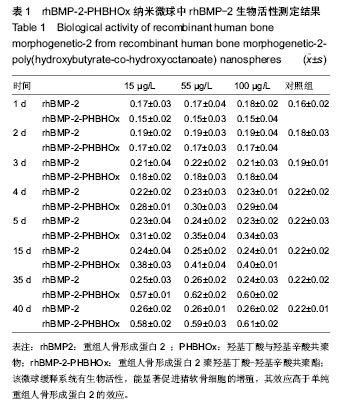中国组织工程研究 ›› 2014, Vol. 18 ›› Issue (52): 8405-8408.doi: 10.3969/j.issn.2095-4344.2014.52.008
• 纳米生物材料 nanobiomaterials • 上一篇 下一篇
聚羟基丁酸-羟基辛酸共聚酯载生长因子的缓释纳米微球
王晓东1,张永红2
- 1山西医科大学骨外科,山西省太原市 030001;2山西医科大学第二临床医学院,山西省太原市 030001
Preparation and performance of recombinant human bone morphogenetic protein-2-poly(hydroxybutyrate-co-hydroxyoctanoate) nanospheres
Wang Xiao-dong1, Zhang Yong-hong2
- 1Department of Orthopedics, Shanxi Medical University, Taiyuan 030001, Shanxi Province, China; 2Second Hospital of Shanxi Medical University, Taiyuan 030001, Shanxi Province, China
摘要:
背景:骨形态发生蛋白2可增加软骨细胞和祖细胞基质的产生,可增强组织金属蛋白酶抑制因子1、sox9基因、Ⅱ型胶原以及聚集蛋白聚糖的表达,具有诱导间充质细胞迁徙、增殖、分化,最终促使软骨、骨形成的作用。
结果与结论:该纳米微球表面光滑圆整,球体大小均匀,粒径为231-415 nm,扫描电镜平均粒径323 nm。微球的包封率和载药量分别为(79.63±0.16)%和(1.92±0.16)%。根据15 d内对重组人骨形态发生蛋白2聚羟基丁酸-羟基辛酸共聚酯纳米微球的体外释药的观察,保持持续释放重组人骨形态发生蛋白2,且释放的浓度呈增长水平。该微球缓释系统有生物活性,能显著促进猪软骨细胞的增殖,其效应高于单纯重组人骨形态发生蛋白2的效应。提示重组人骨形态发生蛋白2聚羟基丁酸-羟基辛酸共聚酯纳米微球缓释系统包封率、载药量、体外释药性以及生物活性符合纳米微球的一般规律,能够满足相应的软骨缺损修复要求。
中图分类号:

.jpg)
.jpg)
.jpg)